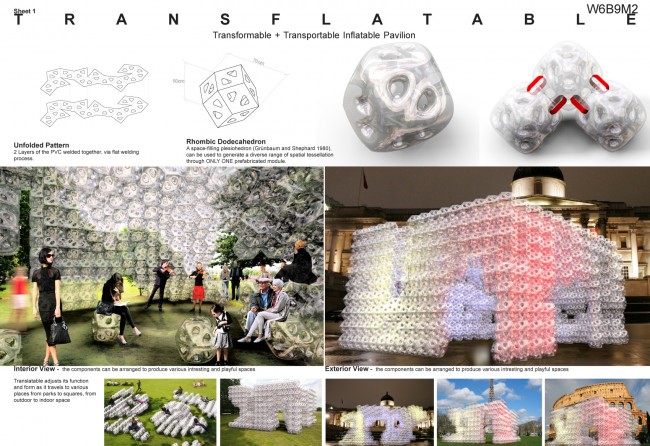Info:
Title: TRANSFLATABLE - Code: W6B9M2Contest: PFFF / 2012
By: M. Gharleghi , A. Sadeghy , D. Araya
Views: 3472 Likes: 0
Votes:
ITALO ROTA2 BENJAMIN BALL6 MARCO CANEVACCI7 VANESSA TODARO4 ANDREA BARTOLI75.2
TRANSFLATABLE
TRANSFLATABLE© ?Inflatable-Transportable-Transformable
The design concept is the aggregation of a single inflatable component, which can be easily produced and assembled in various forms and organizations based on its need, function, site, and performance.
Geometrically, this component is a space-filling rhombic dodecahedron or plesiohedron which can be used to generate a diverse range of spatial tessellation through only one prefabricated module. Because of its geometry, it can be easily pre-fabricated by folding two layers of transparent or translucent PVC and welding them to get the 40x70x40 cm module. These components after inflation can be easily connected via a Velcro belt which can rapidly opened and closed for quick assembly and disassembly. Approximately 1600 components are needed to produce an interesting 50sqm space, while for landscapes and sitting areas the number can be reduced to 500.
Aggregation as an organization system has the benefits of redundancy, robustness, and flexibility. Failure of a few modules will not cause the failure of the whole structure. Increasing damage will decrease performance, but degradation will be gradual, without sudden loss of function. The failure or replacement of a single component will not cause a complete failure of the structure. Individual components can be replaced, yet the emergent structure can remain.
Anchor points can be hidden in between the first layers of the components of the pavilion (see sheet 2). They can be water or sand filled components or simply connected to anchor points such as concrete blocks.
The pavilion can have various functions. It can be used as furniture. Aggregations can produce structure and enclosures. Water filled components can function as anchoring which can be hidden in the aggregation. (See sheet 2)
Components are porous in their default state. The performance of the pavilion and its relationship with the surrounding environment is further enhanced by attaching an inner balloon inside the components located at the outer layer, which can shelter the interior space in severe environmental conditions. (see sheet 2). The injection of dry and non-toxic smoke into the inner tube can transform the pavilion from a semi-transparent into a translucent structure, preventing direct sunlight penetration when needed. (See the tested prototype in sheet 02)
To conclude, the Transflatable is a component which can be simply and economically fabricated, mass produced, installed, and dismantled. By connecting components in different topologies diverse functions emerges. It can be assembled to produce space, shelter, or as an urban landscape. After deflation it can be easily transported.








